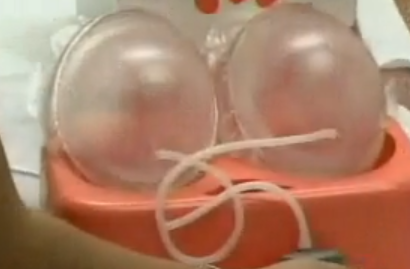The Use of Fat Graft for Breast Augmentation
Fat grafting for breast enhancement has been thought to be a recent advancement for breast plastic surgery. However, the concept of fat grafting was already pioneered in the late nineteenth century by Franz Neuber from Germany. The idea of harvesting fat from areas where there's excess of fat (such as in the lower abdomen, hips or thighs), and using this fat for breast augmentation seems like a great idea. Before one contemplates about fat grafting for breast enlargement, one should be fully informed about this procedure.
Fast Facts about Fat Grafting for Breast Augmentation
- Patients may need to use a device called the Brava device.
- Patients typically use a Brava device 10 hours per day, generally overnight for several weeks before fat injection, and may need to use it for another 1-3 weeks or more.
- The Brava device is a plastic egg-shaped dome used to fit the patient’s breasts. This is used to “create a gentle suction that stimulates tissue growth” per Dr. Khouri, inventor of the Brava device.
- The Brava device costs at least $800.
- Multiple fat grafting may be required to cause a significant increase in breast size.
- The fat graft volume retained one year after surgery ranged from 40 to 70% (average, 55%).
- The main advantage of fat grafting into the breast is the avoidance of any complications associated with saline or silicone gel breast implants.
- The augmented breasts may feel more soft and natural.
Disadvantages of Fat Grafting for Breast Augmentation
- Only a moderate degree of augmentation is possible (possibly 1 cup size).
- There is less projection of the breast with fat grafting when compared with a breast implant, but a more natural contour may be obtained with a fat graft.
- The size of the fat grafted breast will likely decrease in size after 1 year.
- The use of the Brava system for several hours per day before and after fat grafting of the breast may be too cumbersome for some patients.
- The long term effects of injected fat into the breasts are still unknown and currently being studied.
- The injected fat could interfere with mammogram readings, and thus may mask the ability to detect breast cancer. However, a recent French study had shown no statistical difference in terms of breast density findings before and after fat injection.
- The development of fat necrosis after fat transfer into the breasts may lead to formation of liponecrotic cysts and microcalcifications..
- This may interfere with breast cancer screening.
- Incidence of microcalcifications detected on mammograms ranged from 3.9 to 10%.
- Incidence of fat necrosis ranged from 1.2 to 3%.
- Incidence of liponecrotic cysts was 16.7% in one study.
- A recent study showed that clustered microcalcifications, which are typically seen in a certain type of breast cancer (DCIS), was found in 16.7% of patients after fat injection for breast augmentation. This clustered microcalcfication could not be distinguished from the mammographic findings typically seen in breast cancer.
Who are the Best Candidates for Fat Grafting to Enlarge the Breast
- Women who are breast reconstruction candidates including those who have been treated with radiation.
- Women who previously had breast reconstruction and would need revision breast surgery.
- Women with mild breast asymmetry.
- Women who are prepared to comply with strict peri-operative care and guidelines.
As of January 2011, the "American Society for Aesthetic Plastic Surgery and the American Society of Plastic Surgeons, in the interest of patient safety, do not recommend fat grafting for breast enhancement at this time." Currently, it has yet to be determined whether fat grafting has any potentiating effects on breast cancer. The mammographic confusion differentiating between a benign and a malignant calcification still remains a problem after fat grafting for breast augmentation. I recommend asking one of your plastic surgeons regarding fat graft injections for breast enlargement.
References:
ASAPS Press Release: Fat Grafting for Breast Augmentation--What Women Should Know
Illouz YG, Sterodimas A. Autologous fat transplantation
to the breast: a personal technique with 25 years of experience. Aesthetic Plast Surg 2009;33:706-715.Illouz YG, Sterodimas A. Autologous fat transplantation
Parrish et al. Autogenous fat grafting and breast augmentation: a review of the literature. Aesthet Surg J. 2010 Jul-Aug;30(4):549-56.
Veber, et al. Radiographic findings after breast augmentation by autologous fat transfer. Plast Reconstr Surg. 2011 Mar;127(3):1289-99.
Yoshimura K, Sato K, Aoi N, et al. Cell assisted lipotransfer for cosmetic breast augmentation: supportive use of adipose derived stem/stromal cells. Aesthetic Plast Surgery. 2008;32:48-55
Wang, et al. Clinical Analyses of Clustered Microcalcifications after Autologous Fat Injection for Breast Augmentation. Plastic & Reconstructive Surgery. 2011 May; 127: 1669-1673.
Zocchi ML, Zuliani F. Bicompartmental breast lipostructuring. Aesthetic Plast Surg 2008;32:313-328.
Date Updated: May 28, 2011
Wang, et al. Clinical Analyses of Clustered Microcalcifications after Autologous Fat Injection for Breast Augmentation. Plastic & Reconstructive Surgery. 2011 May; 127: 1669-1673.
Zocchi ML, Zuliani F. Bicompartmental breast lipostructuring. Aesthetic Plast Surg 2008;32:313-328.
Date Updated: May 28, 2011




I like your content. I like the way you discuss about breast augmentation that really help me.
ReplyDelete